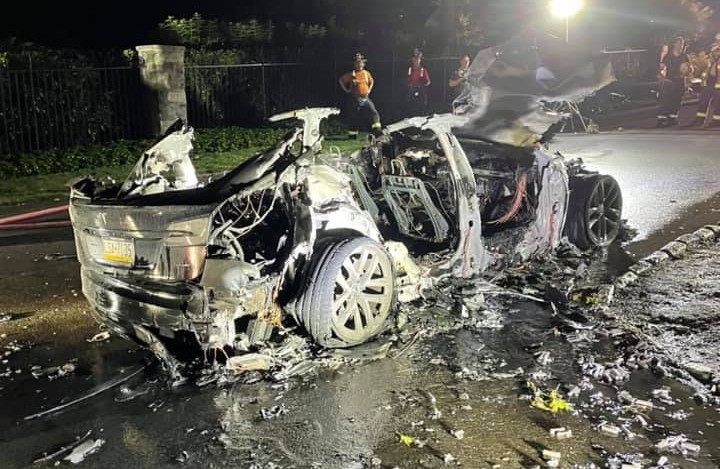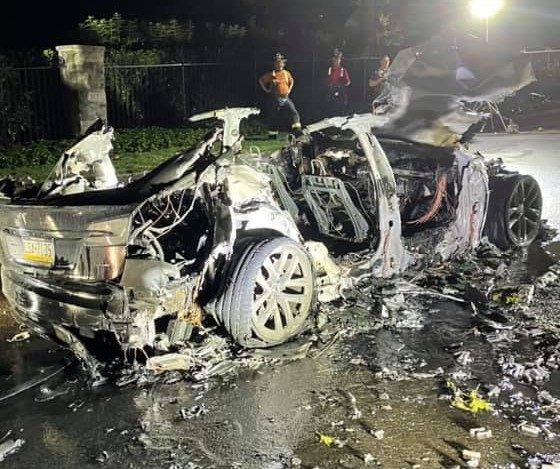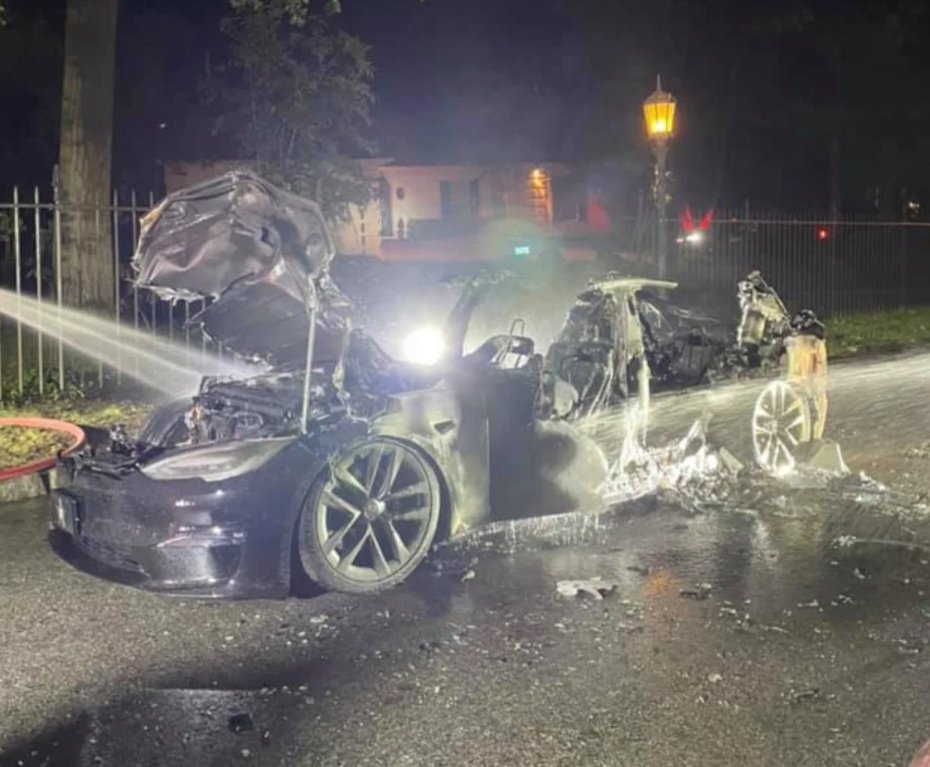

News
Tesla Model S Plaid fire: Strange observations and claims to date
Details about the Tesla Model S Plaid fire on Tuesday are starting to emerge. Similar to other dramatic electric vehicle fires, the details and observations emerging about the Tesla Model S Plaid fire are very interesting.
Accounts of the Model S Plaid fire have been shared by an EMT that reportedly responded to the incident, the chief fire officer for the Lower Merion Township Fire Department in Pennsylvania, and the lawyers representing the Model S Plaid owner.
With this in mind, it is pertinent to provide a view of what each party has stated about the incident so far. Going through each statement would potentially make it a lot easier to come up with a legitimate narrative in the future, especially as official investigations into the fire conclude. That being said, here are the accounts that have been shared on the Tesla Model S Plaid fire earlier this week.

What happened?
The Tesla Model S Plaid caught fire in Haverford, Pennsylvania on June 29, 2021. The vehicle, which was a Plaid variant based on the remains of its rear badge, was engulfed in flames when fire crews arrived. A Facebook post from the Gladwyne Volunteer Fire Company indicated that two fire engines were deployed for the incident. Firefighters were at the scene for about three hours, though the vehicle was cooled down for almost 90 minutes to ensure that the batteries were safe.
“Engine 24 with a crew of 7 arrived on scene simultaneously with Engine 25. Due to prior training classes on Tesla Vehicle Fire emergencies, Engine 24 laid a 5 inch supply line into the scene so that we could keep a continual water stream on the fire to extinguish the fire and cool the batteries down to ensure complete extinguishment. Engine 24 and Engine 25 both deployed hand lines to extinguish the fire, each maintained a dedicated water source and continued to cool the vehicle down for almost 90 minutes. Firefighters were on scene for just over 3 hours dealing with this emergency. Nobody was hurt in the incident, and both crews worked hard in the high heat/humidity to mitigate the incident,” the Gladwyne Volunteer Fire Company wrote.
Interestingly enough, this statement, as well as the Gladwyne Volunteer Fire Company’s Facebook post about the Model S Plaid fire has been taken offline. A look at the fire department’s Facebook page and its official website would reveal that the post about the Tesla fire has now been deleted.

A First Responder’s Account
As the story of the Model S Plaid fire gained ground, the incident started to attract a lot of attention on social media as well. On Reddit, u/wilyson, who claimed to be an EMT who responded to the fire, noted that the report they received about the incident was downright strange. According to the EMT, the person who reported the fire stated that the car was driving uphill without an occupant while it was ablaze. The owner was reportedly nowhere to be found. This was a rather dramatic image, and it promptly fueled speculations among the anti-EV crowd about “self-driving” cars catching fire.
Quite understandably, the EMT noted that he could not provide many details as the police are not releasing more information yet. That being said, the EMT later noted that car fires are very common and that electric vehicles are actually incredibly safe.
The Fire Chief’s Account
As noted in a CNBC report, chief fire officer for the Lower Merion Township Fire Department in Pennsylvania Charles McGarvey stated that the Tesla Model S caught fire on Tuesday while the driver was still at the wheel of the vehicle. According to the fire chief, firefighters eventually removed the Model S Plaid to a complex to safely store it overnight. The vehicle’s owner had since taken the remains of the vehicle from the facility, as per McGarvey, and will have the car investigated independently to determine the cause of the blaze.
The fire chief also stated that his teams had been in touch with Tesla and that some information about the incident should be made public soon. A National Highway Traffic Safety Administration spokesperson also noted that it was aware of the incident and that it is now in touch with relevant agencies and Tesla to gather more information about the fire. “If data or investigations show a defect or an inherent risk to safety exists, NHTSA will take action as appropriate to protect the public,” the NHTSA spokesperson said. The NTSB is not conducting an investigation to date.
The Lawyers’ Account
The Model S Plaid owner’s lawyers, Mark Geragos of Geragos & Geragos in Los Angeles, and Jason Setchen of Athlete Defender in Miami, have since mobilized to share details about the incident as well. In a statement to CNBC, the attorneys stated that the Tesla owner initially noticed smoke coming from the back of the Model S Plaid. Following this, the owner reportedly tried to unlock and open the vehicle’s doors, but he ended up having to force his way out of the car as the locks seemed to malfunction. The lawyers noted that after the Tesla owner left his car, the Model S began to move on its own while flames engulfed it.
Geragos Global attorney Ben Meiselas later posted a tweet sharing an image of the burning Model S. As per the lawyer, “Our firm & @AthleteDefender represent an exec who purchased new Tesla Plaid Model S, which was 1/250 shipped. On Tuesday it spontaneously combusted. Our client was trapped & could have died. We tried reaching out to Tesla & have been ignored so far. This is car after escape.”
Interesting (and strange) details
Overall, the Model S Plaid fire in PA features a number of interesting accounts that may not necessarily line up perfectly. The EMT that initially shared details about the incident mentioned that the Model S owner was nowhere to be found. The lawyers, on the other hand, shared an image reportedly taken immediately after the owner escaped, suggesting that the Tesla owner was on the scene of the blaze. As per the Model S Plaid’s Owner’s Manual, the vehicle is also equipped with a manual door release that should make it easy for occupants to vacate the car in case of an emergency. This seems to be a bit overlooked by the owner’s lawyers, who noted that their client was trapped inside the car.
Of course, the idea of a car driving on its own uphill while being engulfed in flames is quite strange, considering that neither Tesla’s Autopilot nor Full Self-Driving suite have such features. The only function that may have worked similarly is Smart Summon, but the vehicle was burning on a public street, an area where Smart Summon should have been unavailable.
We’ll definitely keep a pulse on this incident, as well as any details that may emerge as investigations go on, so do keep Teslarati on your radar as we follow developments in this event.
Do you have anything to share with the Teslarati Team? We’d love to hear from you, email us at tips@teslarati.com.

Elon Musk
Tesla CEO Elon Musk teases insane capabilities of next major FSD update

Tesla CEO Elon Musk teased the insane capabilities of the next major Full Self-Driving update just hours after the company rolled out version 14.2 to owners.
Tesla Full Self-Driving v14.2 had some major improvements from the previous iteration of v14.1.x. We were on v14.1.7, the most advanced configuration of the v14.1 family, before Tesla transitioned us and others to v14.2.
However, Musk has said that the improvements coming in the next major update, which will be v14.3, will be where “the last big piece of the puzzle finally lands.”
14.3 is where the last big piece of the puzzle finally lands
— Elon Musk (@elonmusk) November 21, 2025
There were some major improvements with v14.2, most notably, Tesla seemed to narrow in on the triggers that caused issues with hesitation and brake stabbing in v14.1.x.
One of the most discussed issues with the past rollout was that of brake stabbing, where the vehicle would contemplate proceeding with a route as traffic was coming from other directions.
We experienced it most frequently at intersections, especially four-way stop signs.
Elon Musk hints at when Tesla can fix this FSD complaint with v14
In our review of it yesterday, it was evident that this issue had been resolved, at least to the extent that we had no issues with it in a 62-minute drive, which you can watch here.
Some owners also reported a more relaxed driver monitoring system, which is something Tesla said it was working on as it hopes to allow drivers to text during operation in the coming months. We did not test this, as laws in Pennsylvania prohibit the use of phones at any time due to the new Paul Miller’s Law, which took effect earlier this year.
However, the improvements indicate that Tesla is certainly headed toward a much more sentient FSD experience, so much so that Musk’s language seems to be more indicative of a more relaxed experience in terms of overall supervision from the driver, especially with v14.3.
Musk did not release or discuss a definitive timeline for the release of v14.3, especially as v14.2 just rolled out to Early Access Program (EAP) members yesterday. However, v14.1 rolled out to Tesla owners just a few weeks ago in late 2025. There is the potential that v14.3 could be part of the coming Holiday Update, or potentially in a release of its own before the New Year.
News
Tesla Full Self-Driving v14.2 – Full Review, the Good and the Bad

Tesla rolled out Full Self-Driving version 14.2 yesterday to members of the Early Access Program (EAP). Expectations were high, and Tesla surely delivered.
With the rollout of Tesla FSD v14.2, there were major benchmarks for improvement from the v14.1 suite, which spanned across seven improvements. Our final experience with v14.1 was with v14.1.7, and to be honest, things were good, but it felt like there were a handful of regressions from previous iterations.
While there were improvements in brake stabbing and hesitation, we did experience a few small interventions related to navigation and just overall performance. It was nothing major; there were no critical takeovers that required any major publicity, as they were more or less subjective things that I was not particularly comfortable with. Other drivers might have been more relaxed.
With v14.2 hitting our cars yesterday, there were a handful of things we truly noticed in terms of improvement, most notably the lack of brake stabbing and hesitation, a major complaint with v14.1.x.
However, in a 62-minute drive that was fully recorded, there were a lot of positives, and only one true complaint, which was something we haven’t had issues with in the past.
The Good
Lack of Brake Stabbing and Hesitation
Perhaps the most notable and publicized issue with v14.1.x was the presence of brake stabbing and hesitation. Arriving at intersections was particularly nerve-racking on the previous version simply because of this. At four-way stops, the car would not be assertive enough to take its turn, especially when other vehicles at the same intersection would inch forward or start to move.
This was a major problem.
However, there were no instances of this yesterday on our lengthy drive. It was much more assertive when arriving at these types of scenarios, but was also more patient when FSD knew it was not the car’s turn to proceed.
Can report on v14.2 today there were ZERO instances of break stabbing or hesitation at intersections today
It was a significant improvement from v14.1.x
— TESLARATI (@Teslarati) November 21, 2025
This improvement was the most noticeable throughout the drive, along with fixes in overall smoothness.
Speed Profiles Seem to Be More Reasonable
There were a handful of FSD v14 users who felt as if the loss of a Max Speed setting was a negative. However, these complaints will, in our opinion, begin to subside, especially as things have seemed to be refined quite nicely with v14.2.
Freeway driving is where this is especially noticeable. If it’s traveling too slow, just switch to a faster profile. If it’s too fast, switch to a slower profile. However, the speeds seem to be much more defined with each Speed Profile, which is something that I really find to be a huge advantage. Previously, you could tell the difference in speeds, but not in driving styles. At times, Standard felt a lot like Hurry. Now, you can clearly tell the difference between the two.
It seems as if Tesla made a goal that drivers should be able to tell which Speed Profile is active if it was not shown on the screen. With v14.1.x, this was not necessarily something that could be done. With v14.2, if someone tested me on which Speed Profile was being used, I’m fairly certain I could pick each one.
Better Overall Operation
I felt, at times, especially with v14.1.7, there were some jerky movements. Nothing that was super alarming, but there were times when things just felt a little more finicky than others.
v14.2 feels much smoother overall, with really great decision-making, lane changes that feel second nature, and a great speed of travel. It was a very comfortable ride.
The Bad
Parking
It feels as if there was a slight regression in parking quality, as both times v14.2 pulled into parking spots, I would have felt compelled to adjust manually if I were staying at my destinations. For the sake of testing, at my first destination, I arrived, allowed the car to park, and then left. At the tail-end of testing, I walked inside the store that FSD v14.2 drove me to, so I had to adjust the parking manually.
This was pretty disappointing. Apart from parking at Superchargers, which is always flawless, parking performance is something that needs some attention. The release notes for v14.2. state that parking spot selection and parking quality will improve with future versions.
Any issues with parking on your end? 14.1.7 didn’t have this trouble with parking pic.twitter.com/JPLRO2obUj
— TESLARATI (@Teslarati) November 21, 2025
However, this was truly my only complaint about v14.2.
You can check out our full 62-minute ride-along below:
Elon Musk
SpaceX issues statement on Starship V3 Booster 18 anomaly
The incident unfolded during gas-system pressure testing at the company’s Massey facility in Starbase, Texas.

SpaceX has issued an initial statement about Starship Booster 18’s anomaly early Friday. The incident unfolded during gas-system pressure testing at the company’s Massey facility in Starbase, Texas.
SpaceX’s initial comment
As per SpaceX in a post on its official account on social media platform X, Booster 18 was undergoing gas system pressure tests when the anomaly happened. Despite the nature of the incident, the company emphasized that no propellant was loaded, no engines were installed, and personnel were kept at a safe distance from the booster, resulting in zero injuries.
“Booster 18 suffered an anomaly during gas system pressure testing that we were conducting in advance of structural proof testing. No propellant was on the vehicle, and engines were not yet installed. The teams need time to investigate before we are confident of the cause. No one was injured as we maintain a safe distance for personnel during this type of testing. The site remains clear and we are working plans to safely reenter the site,” SpaceX wrote in its post on X.
Incident and aftermath
Livestream footage from LabPadre showed Booster 18’s lower half crumpling around the liquid oxygen tank area at approximately 4:04 a.m. CT. Subsequent images posted by on-site observers revealed extensive deformation across the booster’s lower structure. Needless to say, spaceflight observers have noted that Booster 18 would likely be a complete loss due to its anomaly.
Booster 18 had rolled out only a day earlier and was one of the first vehicles in the Starship V3 program. The V3 series incorporates structural reinforcements and reliability upgrades intended to prepare Starship for rapid-reuse testing and eventual tower-catch operations. Elon Musk has been optimistic about Starship V3, previously noting on X that the spacecraft might be able to complete initial missions to Mars.








